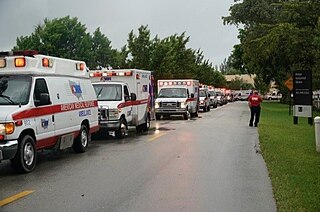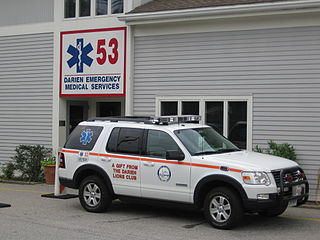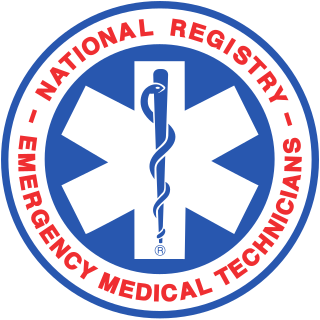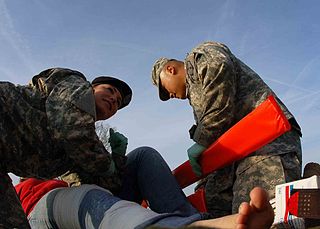Related Research Articles

Emergency medical services (EMS), also known as ambulance services or paramedic services, are emergency services that provide urgent pre-hospital treatment and stabilisation for serious illness and injuries and transport to definitive care. They may also be known as a first aid squad, FAST squad, emergency squad, ambulance squad, ambulance corps, life squad or by other initialisms such as EMAS or EMARS.

An emergency medical technician (EMT), also known as an ambulance technician, is a health professional that provides emergency medical services. EMTs are most commonly found working in ambulances. In English-speaking countries, paramedics are a separate profession that has additional educational requirements, qualifications, and scope of practice.

A paramedic is a health care professional whose primary role is to provide advanced emergency medical care for critical and emergent patients who access the emergency medical system.
The Seattle & King County Emergency Medical Services System is a fire-based two-tier response system providing prehospital basic and advanced life support services.

A medic is a person involved in medicine such as a medical doctor, medical student, paramedic or an emergency medical responder. Among physicians in the UK, the term "medic" indicates someone who has followed a "medical" career path in postgraduate professional training accredited by a College of Physicians, such as cardiology or endocrinology, in contrast to a surgical branch of specialisation accredited by a College of Surgeons.

In the United States Armed Forces, the Combat Medic/Healthcare Specialist is responsible for providing emergency medical treatment at a point of wounding in a combat or training environment, as well as primary care, and health protection and evacuation from a point of injury or illness. Additionally, medics may also be responsible for the creation, oversight, and execution of long-term patient care plans in consultation with- or in the absence of a readily available physician or advanced practice provider. Combat medics may be utilized in hospitals and clinics where they have the opportunity to work in additional roles such as operating medical and laboratory equipment, performing and assisting with procedures, and beyond.

The National Association of Emergency Medical Technicians (NAEMT) is a national Emergency medical services professional association representing all EMTs and Paramedics. The NAEMT educational programs also have an international scope.

A paramedic is a healthcare professional, providing pre-hospital assessment and medical care to people with acute illnesses or injuries. In Canada, the title paramedic generally refers to those who work on land ambulances or air ambulances providing paramedic services. Paramedics are increasingly being utilized in hospitals, emergency rooms, clinics and community health care services by providing care in collaboration with registered nurses, registered/licensed practical nurses and registered respiratory therapists.

In the United States, the paramedic is a professional whose primary focus is to provide advanced emergency medical care for critical and emergency patients who access Emergency Medical Services (EMS). This individual possesses the complex knowledge and skills necessary to provide patient care and transportation. Paramedics function as part of a comprehensive EMS response, under medical oversight. Paramedics perform interventions with the basic and advanced equipment typically found on an ambulance. The paramedic is a link from the scene into the health care system. One of the eligibility requirements for state certification or licensure requires successful completion of a nationally accredited Paramedic program at the certificate or associate degree level. Each state varies in requirements to practice as a paramedic, and not all states require licensure.

Wilderness medicine is defined by difficult patient access, limited equipment, and environmental extremes. Today, wilderness or expedition medicine is practiced by Wilderness First Responders, Wilderness EMTs, Remote/Offshore/Wilderness Paramedics and Physicians on expeditions, in outdoor education, search and rescue, mountain rescue, remote area operations including research, exploration, and offshore oil platforms, as well as tactical environments. In mainland Europe, where mountain rescue is done by paid professionals, there are courses for physicians that help qualify them to be mountain rescue or expedition doctors. Many of these courses lead to an International Diploma in Mountain Medicine, which is recognized by the Union Internationale des Associations Alpinistes.
Wilderness emergency medical technician (WEMT) is an emergency medical technician that is better equipped than licensed healthcare providers, who typically function almost exclusively in urban environments, to better stabilize, assess, treat, and protect patients in remote and austere environments until definitive medical care is reached. Despite the term, WEMT training is available and geared not just to the EMT, but also the paramedic, prehospital registered nurse, registered nurse, physician assistant, and medical doctor. After all, without an understanding of the applicable gear, skills, and knowledge needed to best function in wilderness environments, including a fundamental understanding of the related medical issues more commonly faced, even an advanced provider may often become little more than a first responder when called upon in such an emergency. WEMT training and certification is similar in scope to wilderness advanced life support (WALS) or other courses for advanced providers such as AWLS, WUMP, WMPP, and RMAP. Unlike more conventional emergency medicine training, wilderness emergency medicine places a greater emphasis on long-term patient care in the backcountry where conventional hospital care can be many hours, even days, away to reach.

Louisville Metro Emergency Medical Services is the primary provider of pre-hospital life support and emergency care within Louisville-Jefferson County, Kentucky. LMEMS is a governmental department that averages 90,000 calls for service, both emergency and non-emergency, each year.

In the United States, emergency medical services (EMS) provide out-of-hospital acute medical care and/or transport to definitive care for those in need. They are regulated at the most basic level by the National Highway Traffic Safety Administration, which sets the minimum standards that all states' EMS providers must meet, and regulated more strictly by individual state governments, which often require higher standards from the services they oversee.

The National Registry of Emergency Medical Technicians is a US certification agency covering prehospital medical providers.
Advanced emergency medical technician (AEMT) is provider of prehospital emergency medical services in the United States. A transition to this level of training from the Emergency Medical Technician-Intermediate (EMT-I), which had somewhat less training, began in 2013 and has been implemented by most states at this point. The AEMT is not intended to deliver definitive medical care in most cases, but rather to augment prehospital critical care and provide rapid on-scene treatment. AEMTs are most usually employed in ambulance services, working in conjunction with EMTs and paramedics, however are also commonly found in fire departments and law enforcement agencies as non-transporting first responders. Ambulances operating at the AEMT level of care are commonplace in rural areas, and occasionally found in larger cities as part of a tiered-response system, but are overall much less common than EMT and Paramedic level ambulances. The AEMT provides a low-cost, high-benefit option to provide advanced-level care when the paramedic level of care is not feasible. The AEMT is authorized to provide limited advanced life support, which is beyond the scope of an EMT.
Emergency Medical Technician is the entry level of Emergency Medical Technician in the United States.
In the United States, the licensing of prehospital emergency medical providers (EMTs) and oversight of emergency medical services are governed at the state level. Each state is free to add or subtract levels as each state sees fit. Therefore, due to differing needs and system development paths, the levels, education requirements, and scope of practice of prehospital providers varies from state to state. Even though primary management and regulation of prehospital providers is at the state level, the federal government does have a model scope of practice including minimum skills for EMRs, EMTs, Advanced EMTs and Paramedics set through the National Highway Traffic Safety Administration (NHTSA).

Emergency medical responders are people who are specially trained to provide out-of-hospital care in medical emergencies. There are many different types of emergency medical responders, each with different levels of training, ranging from first aid and basic life support. Emergency medical responders have a very limited scope of practice and have the least amount of comprehensive education, clinical experience or clinical skills of emergency medical services (EMS) personnel. The EMR program is not intended to replace the roles of emergency medical technicians or paramedics and their wide range of specialties. Emergency medical responders typically assist in rural regions providing basic life support where pre-hospital health professionals are not available due to limited resources or infrastructure.
William 'Will' R. Smith, is an emergency physician and wilderness medicine consultant who lectures about integrating combat medicine into wilderness rescues around the world. He started Wilderness & Emergency Medicine Consulting, a company that helps people with pre-trip planning, online medical support, travel medicine in remote areas and provides expert witness testimony in court cases related to wilderness medicine. As medical director for the National Park Service, he oversaw the largest rescue event ever to occur in Grand Teton National Park. He lives in Jackson, Wyoming where he is an emergency medicine physician at St. John’s Medical Center.
References
- 1 2 3 Dudley, Brier (March 2, 2009). "Global link to medics a call away". The Columbus Dispatch . Retrieved 19 July 2013.
- ↑ Eric Hal Schwartz, XCONOMY (2009-08-11). "12 Tech Firms in WA Make Inc. 500". seattlepi.com. Retrieved 2013-07-20.
- ↑ "The Best Places to Work …and Play (Page 3)". Seattle Met. 2011-04-22. Retrieved 2013-07-20.
- ↑ "Remote Medical International Uses $8M in Capital to Embark on Expansion". Reuters. Archived from the original on 2013-07-10. Retrieved 2013-07-20.
- ↑ "Remote Medical International Launches RMI CONNECT(TM)". MarketWatch. Retrieved 2013-07-20.
- ↑ Fontaine, Scott (2009-08-19). "Local News | Fort Lewis medics train for Afghanistan mountains | Seattle Times Newspaper". Seattletimes.com. Retrieved 2013-07-20.
- Remote Medical International provides emergency services to travelers in distant locations. Puget Sound Business Journal.
- Remote Medical International: to your (global) health. Seattle Business.